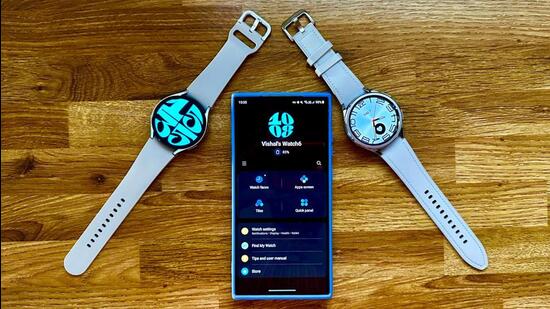Smartwatches for Android phones are still evolving. There is still a search for refinement, and it often feels as though Google, chip makers for wearables and watch makers aren’t always working in sync; experience gaps aplenty. The outlier, a silver lining, is Samsung. With a robust ecosystem as the foundation, the Galaxy Watch series emerges as the most mature smartwatch experience, paired with an Android phone. The latest generation, the Galaxy Watch 6 and the Galaxy Watch 6 Classic are a step forward in that sense.

When you do get down to choosing one, it is still a complicate portfolio to navigate. The Watch 6 in 40mm and 44mm sizes, with 4G or without. The Galaxy 6 Classic can be had in 43mm and 47mm sizes, again with the choice of just Bluetooth, or Bluetooth and 4G connectivity. The former, priced ₹29,999 onwards while the slightly loftier Classic edition costs ₹36,999 onwards.
If you get a sense of having seen these watches, particularly the Galaxy Watch 6 before, you’d be partially correct. There is continuity in design, more so with the Galaxy Watch 6 than the Galaxy Watch 6 Classic. The latter, stands out a bit more because Samsung has given it back what it always deserved – a rotating bezel. You hear a reassuring click-click-click-click as you rotate this dial to navigate on-screen menus. Rather more intuitive too, particularly opposed to swipe gestures on a watch’s rather compact screen.
Also read:Samsung Galaxy Z Fold 5 is all about polish, a new hinge and benchmark refresh
It is not as if the Galaxy Watch 6 doesn’t get a dose of the new. The bezels are slimmer than before, as much as 30%, which give it a leaner look. To be fair, I’d recommend a 44mm watch size if this is the variant you’re opting for. There will be more display real estate to work with for convenience, while a few millimetres have already been shaved off. The Galaxy Watch 6 Classic is of course wider, and there is a reassuring heft. You know good quality stainless steel has been used. The Galaxy Watch 6 is made of aluminium.
It mustn’t have been easy for Samsung to have given these watches slightly bigger displays compared with their predecessors from 2022, without any perceptible increase in footprint. That as big a win for ergonomics, as there could have ever been.
On the inside, the Galaxy Watch 6 series gets a new Exynos W930 chip, which is claimed to be as much as 18% faster than the chip in the last generation watches. It may be difficult to notice that sort of performance difference with apps on a watch, but what’s more definitely noticeable are the improvements with Google’s Wear OS 4 and the Samsung One UI 5 overlay on that – app response is snappier, navigation transitions are smoother and occasional moments of sluggishness haven’t shown up in these watches thus far.
This is as a good a time as any to talk about the widening scope of wellness tools, and why you must use the Galaxy Watch 6 series with a Samsung Galaxy phone for best results. The Biosensor that enables heart rate, electrocardiogram (ECG or EKG) and body data with the Bioelectrical Impedance Analysis (BIA) work as they should only when the watch is paired with a Samsung phone, and the latest version of the Samsung Health Monitor app installed.
Also read:Samsung Galaxy Z Flip 5’s pursuit of refinement drubs Motorola’s Razr 40 Ultra
In our tests, we compared the heart rate readings of the Galaxy Watch 6 and the Garmin Epix 2, when worn together during outdoor runs or jogs. There were times when the Galaxy Watch 6 and Galaxy Watch 6 Classic returned slightly lower readings (it ranged between 3 and 7 points) than the Epix 2’s readings. Not sure what to make of it, but you may want to keep that in mind when reading the collected data.
Sleep coaching, as an example, needs data for 7 days before it can start calculating your sleep quality and generate any suggestions. The temperature sensors feed the readings directly into the advanced cycle tracking feature on the Health app. Or the skin temperature data to go with the sleep data. It is now a multi-layered approach towards health and wellness metrics if you’re interested.
Samsung has also brought back automatic detection for cycling workouts. Even now, automatic detection for walks, runs, etc. still happens after 10 minutes or so of continuous activity. New additions are also the personalised heart zones. Just last month, the Galaxy Watch 6 series got the US Food and Drug Administration (FDA) clearance for irregular heart rhythm notifications. But it wouldn’t work without the Samsung Health app.
There were battery capacity bumps too with the Galaxy Watch 6, and that’s had a very apparent positive impact. The Galaxy Watch 6 Classic, for instance, when used an entire day (this included mirroring phone notifications), it ends a 12-hour cycle with about 54% battery still available. You could theoretically get through two days of use, but if sleep tracking is on the agenda, we are still looking at a daily charge routine. Mind you, we noticed certain instances where stand-by battery drain is more than you’d factor in – one afternoon, it dipped from 80% to 64% in just one hour, whilst there were no notifications to handle too.
Also read:New battles define a slowing Indian smartphone market
If you are approaching this potential purchase decision with the age-old question about whether the improvements are broad enough to warrant an upgrade, you’d be going down the wrong track. We are firmly in the era of incremental improvements; the larger, more wholesale changes don’t happen with every generation. In that sense, even Galaxy Watch 5 series owners would draw benefits from significantly improved battery life.
Perhaps not so much in terms of experience and the range of health and wellness tracking apps (most are replicated on both generations of Galaxy Watch series), but subtle tweaks to the design are additionally more profound for owners of earlier Samsung smartwatches.
The Tizen OS smartwatch era has well and truly evolved into one where Samsung tightly controls the experience, though Google Wear OS provides the foundations. Software updates, how software and hardware work together and optimising the chip for what it is supposed to do. Perhaps that’s an example for any other smartwatch makers, who are struggling with a defragmentation of experience. Samsung’s smartwatch evolution comes through as one voice, not a confusing cacophony of opinions from any stakeholders.
